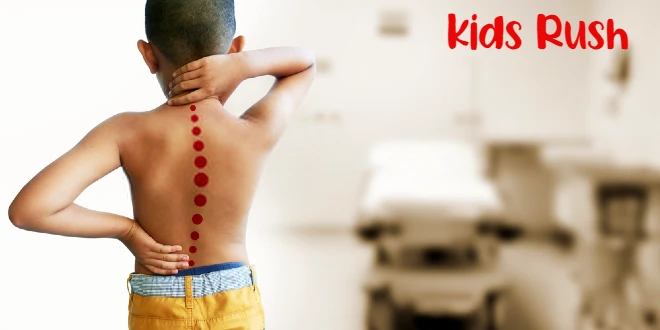An Overview Of Neck Pain in Children
All ages are susceptible to neck pain, including children. Pain is usually caused by muscle strains or injuries, but your child should not be ignored when he or she complains. Symptoms of a serious illness can sometimes accompany a fever. Several studies have not yet been conducted on children and adolescents’ neck pain. In a 2014 article published in the Brazilian Journal of Physical Therapy, back and neck pain were cited as a top cause of disability in adolescents, and 25 percent of those cases affected physical activity or school participation. Having knowledge of potential causes of neck pain and knowing how to check for injuries are important skills for parents to possess. Knowing when to see a doctor will make it easier for you to make an informed decision. Small neck injuries are usually treatable at home in a few days and should go away on their own.
Symptoms of neck pain in children
- There is pain behind the neck
- Shoulder blade pain
- Neck movement is limited
- Stiffening the head
- A slight tilt of the head
- The glands are swollen and tender to the touch
The chin may have difficulty touching the chest of your child if their neck is stiff. Symptoms of meningitis include fever and a stiff neck.
Read Also: Jaw Pain In Children: Causes, Diagnosis, and Treatment
Causes of neck pain in children
Children’s neck pain can be caused by several factors. Sports players or children who are active are likely to experience muscle strains or sprains during their activities. Pain in the neck can also result from trauma such as a car crash or falling. The improper placement of the head when sitting or sleeping, computer use, or carrying a heavy backpack can lead to neck pain. Infections can also cause neck pain caused by swollen glands. According to an article in Chiropractic and Manual Therapies, children can experience back and neck pain, but the pain is usually mild and temporary. Some children can suffer from more severe types of disability, and pain may gradually spread to other areas of the spine and become more intense, frequently resulting in musculoskeletal problems in adults.
Related: Causes of leg pain in children
At what point does it become more serious?
The following conditions may cause neck stiffness or pain more seriously but are rare:
- meningitis
- tick bites
- cancer
- rheumatoid arthritis
The symptoms of meningitis, such as fever, headache, hypersensitivity to light, poor feeding, nausea and vomiting, and rash, should be treated immediately if you are experiencing neck pain or stiffness. From mild symptoms to severe symptoms and death, meningococcal disease can quickly progress, according to a 2006 article in The Lancet. In the event of a medical emergency, seeking treatment as quickly as possible is crucial. It is also possible to get Lyme disease from ticks. Tick bites are often responsible for spreading this disease. Check for bug bites on your neck. The area around the bite marks will often appear red or rashy. The following symptoms may also be present in children:
- nausea
- weakness
- headache
- swollen lymph nodes
- fever
- muscle and joint pains
An injured child should receive immediate medical attention after being hurt in a car accident or when they fall.
A neck injury inspection
Before getting your child to the doctor, you can inspect his or her neck and shoulders at home if the injury looks mild and has no traumatic onset. Inspect your children’s skin for the appearance of signs of trauma, such as bruising, redness, swelling, and warmth. Bring them in front of you and instruct them to look directly in front of you. You may want to tell them to tilt their heads to one side and then the other. You might also want to ask them if there is any pain or if one side is worse than the other. Examine their body from the top and from the bottom to identify areas of stiffness and pain. While your child is playing or eating, you should watch out for signs of weakness in the muscles. Check to see if your child feels any tingling, numbness, or weakness in their neck, upper back, or arms. All of these symptoms should be addressed immediately by a medical professional. Pain may prevent your child from communicating. If your loved one has difficulty bending to one side, sleeping or sitting still, or using arms during activities, you should be on the lookout. A neck injury, weakness, or nerve injury can occasionally cause these symptoms.
How to treat a minor neck injury at home
Several times a day, apply moist heat or ice to tensioned muscles for 10 to 15 minutes to relieve muscle pain. As long as the pain persists, it is best to prevent aggravating activities. Additionally, you can instruct your child to hold a 30-second position in which they tilt their head to one side until they feel a stretch in their neck. On the other side, repeat the process. A similar stretch can also be done by tilting one’s head towards one’s armpit and gently pulling down the head until the muscles are stretched. Getting your head turned both forward and backward and moving your shoulders forward and backward are other gentle stretching techniques. Breathing techniques like deep breathing and relaxation can also help reduce tension in the neck and shoulders. Strains and sprains can temporarily be relieved by taking pain medication such as acetaminophen or ibuprofen. As your child grows older, limiting their screen time may help prevent them from developing neck problems. Researchers have found an association between the use of computers and an increase in neck-shoulder and low back pain in adolescents in a study published in the European Journal of Public Health. Two to three hours of computer use each day or more is associated with an increased risk of neck-shoulder pain.
When to visit the doctor
Consult your child’s doctor if:
- Three or four days after experiencing the pain, it is not understood
- For short periods of time, the pain disappears, but then comes back
- The activities your child normally performs are difficult for them
Call 911 or the nearest emergency room if:
- After taking pain medication, the pain persists for more than two hours
- You feel numb in your arms or back
- A fever is over 38°C (100.4°F) and your child has a stiff neck
- Drooling or difficulty swallowing is the result of your child
- Your child seems very ill
The Bottom Line
Be sure to observe any other symptoms your child displays when complaining of neck pain. When you have severe pain, are experiencing a traumatic incident, or are experiencing other symptoms, seek medical attention immediately. A heavy backpack, poor ergonomics, or falling asleep while using a laptop or tablet may be responsible for your child’s frequent complaints about neck pain. For recurrent neck pain prevention, inform your pediatrician and consult an occupational or physical therapist.


